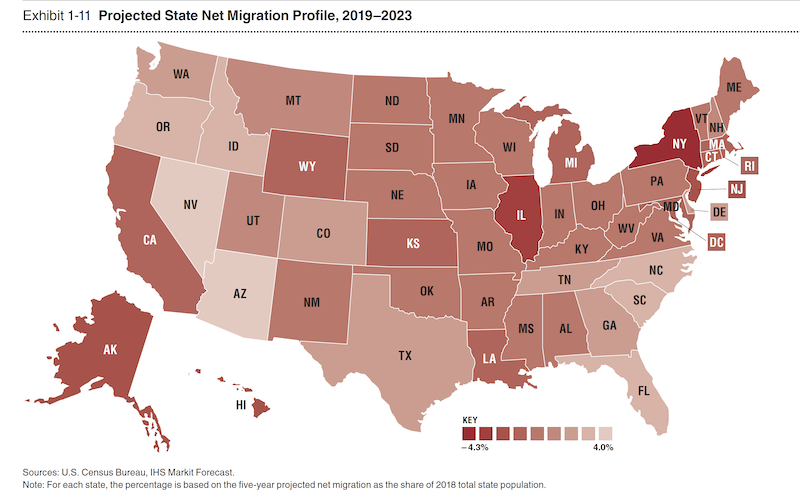The current record-setting expansion in the U.S. economy and its real estate sector, which dates back to the start of this decade, should continue through 2021, but at a moderated pace.
That’s the consensus prediction, based on a recent survey of 41 economists and analysts at 32 leading real estate organizations. Those experts’ opinions about all things real estate—from transaction volumes and pricing to returns on investment and housing development—form the basis of the Urban Land Institute’s Real Estate Economic Forecast, which ULI released last week.
The trends that are likely to drive the pace of that growth are identified in Emerging Trends in Real Estate 2020, which ULI and PwC, the accounting and research firm, released last month. That 92-page report is based on survey responses from 1,450 people working for various real estate-related businesses (nearly 28% of whom are private property owners or developers), and 750 individuals whom the report’s researchers interviewed personally.
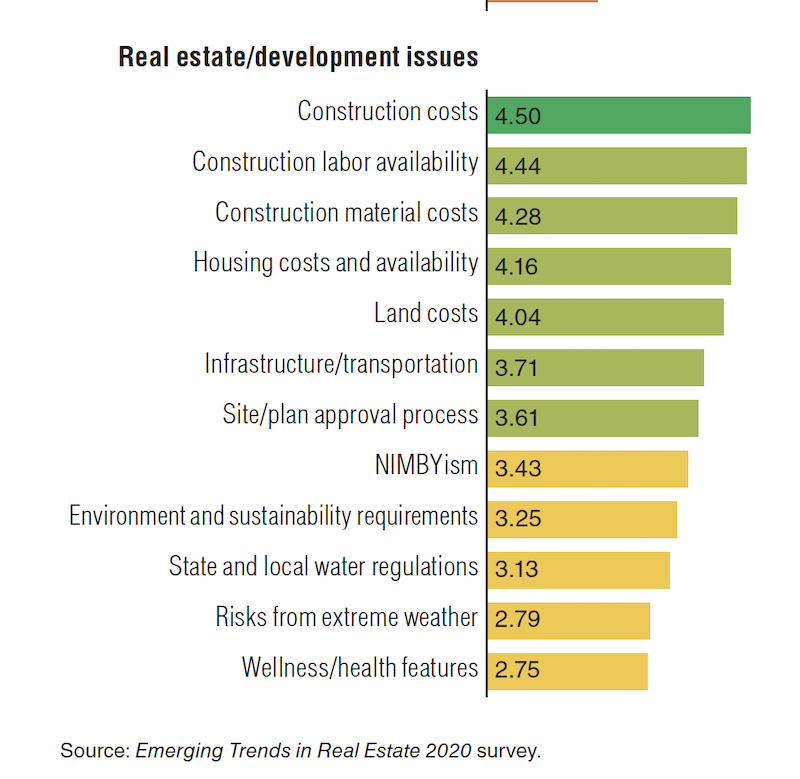
Rising construction costs lead the areas of concern that could stymie real estate growth.
Austin ranks first out of 80 metros in the U.S. for having the greatest potential for real estate for 2020, followed by Raleigh-Durham, N.C., Nashville, Charlotte, and Boston. The Emerging Trends report assesses which markets are worth watching by six criteria that include population projections, homebuilding prospects, investor demand, and redevelopment opportunities.
Manhattan and Chicago will continue to lead the pack as capital magnets for real estate investment. Philadelphia and Long Island, N.Y., are among the metros with sustained track records for capital flow and transaction volume. And Jacksonville, Fla., Salt Lake City, and Columbus, Ohio, are deemed “treasures ripe for discovery.”
The report makes “buy-hold-sell” recommendations within metros for different building types. For example, nearly three-fifths of respondents gave Oakland/East Bay in California a “buy” recommendation for office properties. Orlando ranked highest for multifamily properties, Nashville for retail, Charleston, S.C., for hotels.
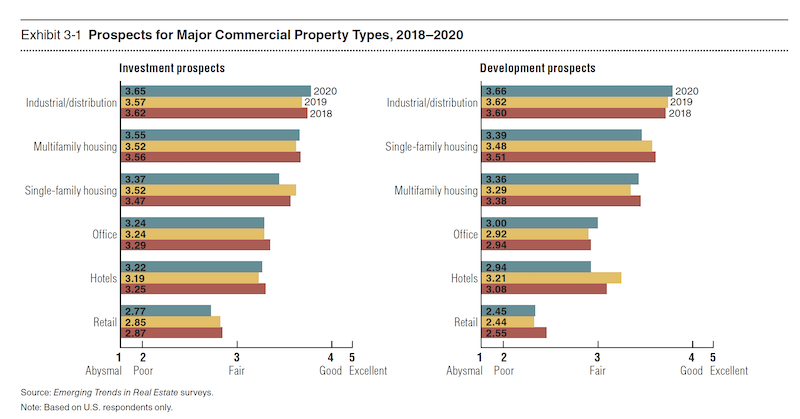
Warehouse distribution, in an era of online shopping, continues to be seen as fertlle for future development.
Nationally, industrial buildings, such as warehouses, have the greatest prospects among commercial real estate property types for 2020 in terms of their return performance and growth outlook, followed by multi- and single-family housing.
This report, though, isn’t all upbeat. Among the trends it spots is an “extended downshifting” in the economy, which is likely to have implications for commercial property demand “in the decades ahead.” The report warns against “a surfeit of capital desperately seeking placement,” which could create a real estate bubble. And the repot sees affordable housing at “a breaking point” of inadequate supply. One attempted solution: the rise in coliving.
The report sees increasing demand for communities that can deliver an authentic sense of place “rather than concocted through prescribed programming and business goals.” It also sees live-work-play districts breaking out of their urban enclaves and expanding to suburban communities to create “hipsturbias.” Real estate development in “hipsturbs” and urban downtowns should benefit from baby boomers’ expectations of staying active as they age.
Infrastructure construction and improvement are more likely to be initiated by state and local, rather than federal, governments that see them as foundations of their cities’ economic growth. And property managers are turning to technology for productivity enhancements and operational efficiencies.
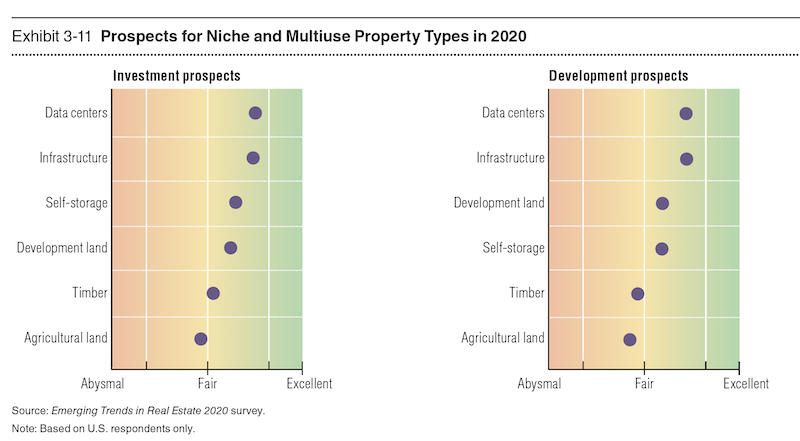
Data centers and infrastructure are two building types where experts foresee better than average growth prospects.
Many of these trends are premised on economic assumptions that ULI lays out in its Real Estate Economic Forecast. It expects the U.S. gross domestic product to increase by 2.3% this year 1.7% next year, and 1.9% in 2021. Net job growth should average 1.7 million per year through 2021. Yields on 10-year U.S. Treasury notes are expected to decline, which ULI states “should be a positive for real estate values.”
Real estate transaction volumes are expected to moderate over the forecast period, from a projected $475 billion this year to $415 billion in 2021. Real estate price growth is also expected to slow, from 5.1% this year to 3.9% in 2021.
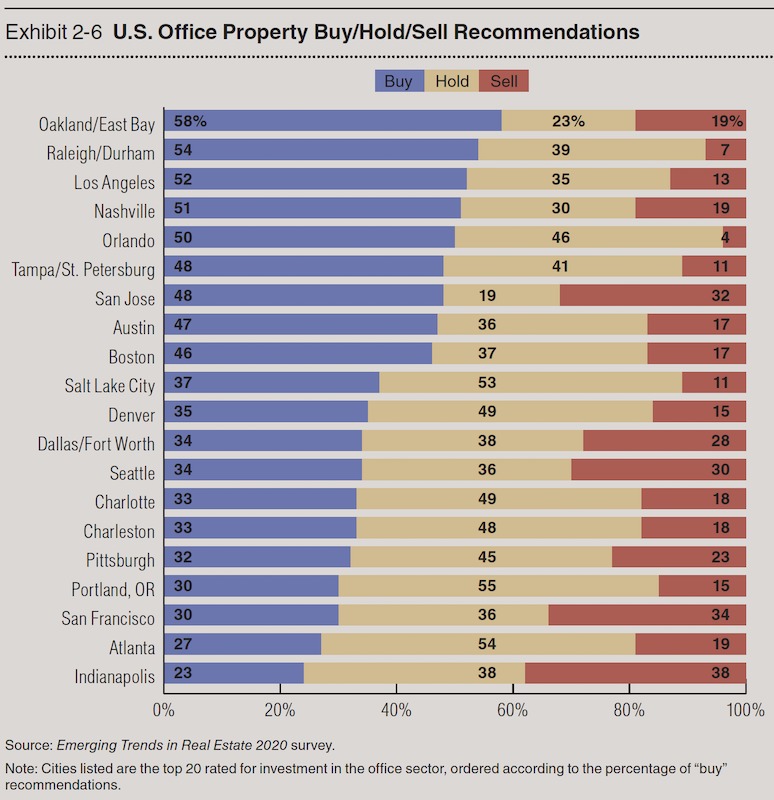
The Oakland, Calif., market remains ripe for office development and construction.
Rent growth should be flat for all building types except industrial and hotels, which will see declines. National vacancy rates will rise slightly, predicts economists.
Total real estate returns, as well as equity real estate investment trust returns, are expected to be strong over the next two years. On the flip side, increasing construction costs are tamping down single-family housing, to the point where ULI’s report is forecasting an annual average, through 2021, of between 800,000 and 850,000 units delivered, well below the long-term annual average of 975,000. Home prices, though, should continue to average 3.2% growth per year over the forecast period.
Related Stories
Market Data | May 29, 2018
America’s fastest-growing cities: San Antonio, Phoenix lead population growth
San Antonio added 24,208 people between July 2016 and July 2017, according to U.S. Census Bureau data.
Market Data | May 25, 2018
Construction group uses mobile technology to make highway work zones safer
Mobile advertising campaign urges drivers who routinely pass through certain work zones to slow down and be alert as new data shows motorists are more likely to be injured than construction workers.
Market Data | May 23, 2018
Architecture firm billings strengthen in April
Firms report solid growth for seven straight months.
Market Data | May 22, 2018
Vacancies stable, rents rising, and pipeline receding, according to Transwestern’s 1Q US Office Market report
The Big Apple still leads the new construction charge.
Market Data | May 18, 2018
Construction employment rises in 38 states and D.C. from April 2017 to April 2018
California & West Virginia have biggest annual job gains, North Dakota has largest decline; California & Louisiana have largest monthly pickup, Indiana & North Dakota lead monthly drops.
High-rise Construction | May 18, 2018
The 100 tallest buildings ever conventionally demolished
The list comes from a recent CTBUH study.
Resiliency | May 17, 2018
Architects brief lawmakers and policy-makers on disaster recovery as hurricane season approaches
Urge senate passage of disaster recovery reform act; Relationship-building with local communities.
Market Data | May 17, 2018
These 25 cities have the highest urban infill development potential
The results stem from a COMMERCIALCafé study.
Market Data | May 10, 2018
Construction costs surge in April as new tariffs and other trade measures lead to significant increases in materials prices
Association officials warn that the new tariffs and resulting price spikes have the potential to undermine benefits of tax and regulatory reform, urge administration to reconsider.
Market Data | May 7, 2018
Construction employers add 17,000 jobs in April and 257,000 for the year
Unemployment rate for construction increases slightly compared to year earlier as higher pay levels appears to be attracting people with recent construction experience back into the workforce.


